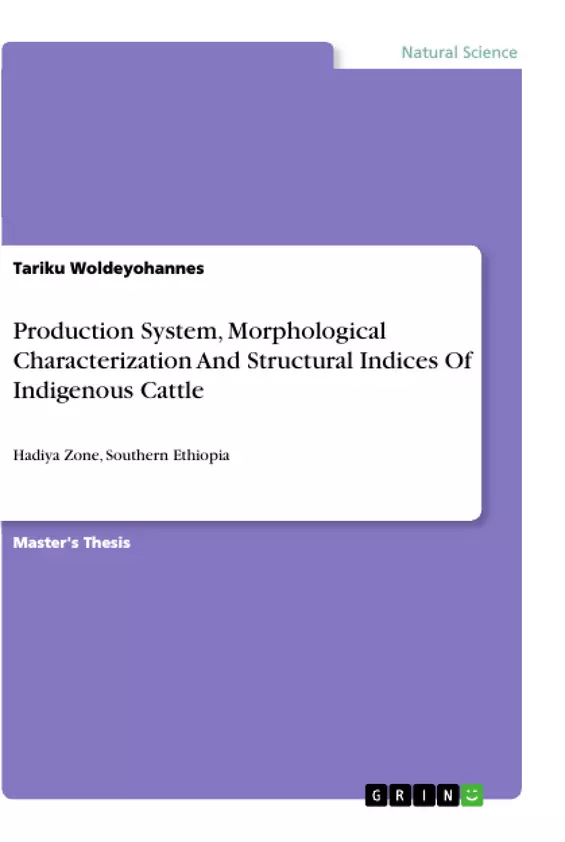The study was conducted in Soro and Misha districts of Hadiya zone Southern Ethiopia. The objectives of the study were; to describe the production system, to characterize indigenous cattle breeds by using economically important traits and to develop structural indices to assess type and function of cattle using morphometrical traits. The study was undertaken to describe the production system, the cattle by using qualitative and quantitative traits.
Field studies and collection of data were carried out by using semi-structured questionnaire, observation, key informants, focused group discussion and linear body measurements of sampled cattle and also from secondary data sources. A total of 240 households (120 from each district) were selected by using stepwise purposive followed by random selection method for questionnaire interview and 660 cattle (480 cows and 180 bulls) for morphological description and to measure quantitative and qualitative traits of cattle.
The qualitative traits are assessed by visual observation while the qualitative traits were measured by using self devised instruments by the researcher. The data were analyzed by SPSS software, while the qualitative traits were compared by using Chi-square test, the quantitative traits were compared by Duncan’s multiple range test and the values were compared at the significance level P<0.05.
Inhaltsverzeichnis (Table of Contents)
- INTRODUCTION
- Background
- Statement of the problem
- Objectives of the study
- General objectives
- Specific objectives
- Research questions
- Hypotheses
- MATERIALS AND METHODS
- Study area
- Location and climate
- Socioeconomic status of the community
- Data collection methods and procedures
- Data collection methods
- Sampling procedures
- Data analysis
- RESULTS AND DISCUSSION
- Socioeconomic characteristics of the farmers
- Descriptive analysis of farmers’ characteristics
- Production system of indigenous cattle
- Cattle production systems in Hadiya zone
- Management practices
- Morphological characteristics of indigenous cattle
- Body weight and linear body measurements
- Body condition score
- Structural indices of indigenous cattle
- Body weight and linear body measurements
- Body condition score
- CONCLUSION AND RECOMMENDATIONS
Zielsetzung und Themenschwerpunkte (Objectives and Key Themes)
This thesis aims to investigate the production system, morphological characteristics, and structural indices of indigenous cattle in Hadiya Zone, Southern Ethiopia. The study also seeks to understand the socioeconomic characteristics of farmers and their relationship with the production system of these cattle.
- Indigenous cattle production systems in Hadiya Zone
- Morphological characteristics of indigenous cattle
- Structural indices of indigenous cattle
- Socioeconomic characteristics of farmers
- The impact of these factors on cattle production
Zusammenfassung der Kapitel (Chapter Summaries)
- Introduction: This chapter sets the context for the study, outlining the importance of indigenous cattle in Ethiopia, the challenges faced by livestock producers, and the research gaps that this study seeks to address. It also defines the objectives and research questions of the study.
- Materials and Methods: This chapter describes the study area, the data collection methods, and the sampling procedures used in the study. It also details the statistical analysis methods used to analyze the collected data.
- Results and Discussion: This chapter presents the results of the study, focusing on the socioeconomic characteristics of farmers, the production system of indigenous cattle, the morphological characteristics of these cattle, and their structural indices. The chapter then discusses the implications of these findings.
Schlüsselwörter (Keywords)
This study focuses on indigenous cattle, production systems, morphological characteristics, structural indices, socioeconomic characteristics, and Hadiya Zone in Southern Ethiopia. The research utilizes data collection methods, statistical analysis, and aims to provide insights into sustainable livestock management practices.
- Quote paper
- Tariku Woldeyohannes (Author), 2018, Production System, Morphological Characterization And Structural Indices Of Indigenous Cattle, Munich, GRIN Verlag, https://www.grin.com/document/517303



